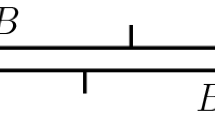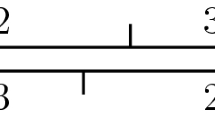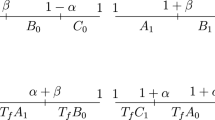Astract
We describe an algorithm for generating the symbolic sequences which code the orbits of points under an interval exchange transformation on three intervals. The algorithm has two components. The first is an arithmetic division algorithm applied to the lengths of the intervals. This arithmetic construction was originally introduced by the authors in an earlier paper and may be viewed as a two-dimensional generalization of the regular continued fraction. The second component is a combinatorial algorithm which generates the bispecial factors of the associated symbolic subshift as a function of the arithmetic expansion. As a consequence, we obtain a complete characterization of those sequences of block complexity 2n+1 which are natural codings of orbits of three-interval exchange transformations, thereby answering an old question of Rauzy.
Similar content being viewed by others
References
V. I. Arnold,Small denominators and problems of stability of motion in classical and celestial mechanics, Uspekhi Mat. Nauk18 (1963), 91–192; translated in: Russian Math. Surveys18 (1963), 86–194.
P. Arnoux and G. Rauzy,Représentation géométrique de suites de complexité 2n+1, Bull. Soc. Math. France119 (1991), 199–215.
V. Berthé, N. Chekhova and S. Ferenczi,Covering numbers: arithmetics and dynamics for rotations and interval exchanges, J. Analyse Math.79 (1999), 1–31.
M. Boshernitzan and C. Carroll,An extension of Lagrange's theorem to interval exchange transformations over quadratic fields, J. Analyse Math.72 (1997), 21–44.
J. Cassaigne,Complexité et facteurs spéciaux, Bull. Belg. Math. Soc.4 (1997), 67–88.
E. M. Coven and G. A. Hedlund,Sequences with minimal block growth, Math. Systems Theory7 (1972), 138–153.
A. del Junco,A family of counterexamples in ergodic theory, Israel J. Math.44 (1983), 160–188.
G. Didier,Échanges de trois intervalles et suites sturmiennes, J. Théor. Nombres Bordeaux9 (1997), 463–478.
X. Droubay, J. Justin and G. Pirillo,Epi-Sturmian words and some constructions of de Luca and Rauzy, Theoret. Comput. Sci.255 (2001), 539–553.
F. Durand,A characterization of substitutive sequences using return words, Discrete Math.179 (1998), 89–101.
S. Ferenczi,Rank and symbolic complexity, Ergodic Theory Dynam. Systems16 (1996), 663–682.
S. Ferenczi,Systems of finite rank, Colloq. Math.73 (1997), 35–65.
S. Ferenczi, C. Holton and L. Zamboni,The structure of three-interval exchange transformations I: an arithmetic study, Ann. Inst. Fourier51 (2001), 861–901.
S. Ferenczi, C. Holton and L. Zamboni,The structure of three-interval exchange transformations III: ergodic and spectral properties; preprint 2001–26, http://iml.univ-mrs.fr/editions/preprint2001/preprint2001.html.
C. Holton and L. Zamboni,Descendants of primitive substitutions, Theoret. Comput. Systems32 (1999), 133–157.
A. B. Katok and A. M. Stepin,Approximations in ergodic theory, Uspekhi Mat. Nauk22 (1967), 81–106; translated in: Russian Math. Surveys22 (1967), 76–102.
M. S. Keane,Interval exchange transformations, Math. Z.141 (1975), 25–31.
M. Morse and G. A. Hedlund,Symbolic dynamics II. Sturmian trajectories, Amer. J. Math.62 (1940), 1–42.
G. Rauzy,Échanges d'intervalles et transformations induites, Acta Arith.34 (1979), 315–328.
R. Risley and L. Q. Zamboni,A generalization of Sturmian sequences: combinatorial structure and transcendence, Acta Arith.95 (2000), 167–184.
M.-L. Santini-Bouchard,Échanges de trois intervalles, et suites minimales, Theoret. Comput. Sci.174 (1997), 171–191.
W. A. Veech,The metric theory of interval exchange transformations I, II, III, Amer. J. Math.106 (1984), 1331–1421.
A. M. Vershik and A. N. Livshits,Adic models of ergodic transformations, spectral theory, substitutions, and related topics, Adv. Soviet Math.9 (1992), 185–204.
Author information
Authors and Affiliations
Corresponding author
Additional information
Partially supported by NSF grant INT-9726708.
Rights and permissions
About this article
Cite this article
Ferenczi, S., Holton, C. & Zamboni, L.Q. Structure of three-interval exchange transformations II: a combinatorial description of the tranjectories. J. Anal. Math. 89, 239–276 (2003). https://doi.org/10.1007/BF02893083
Received:
Revised:
Issue Date:
DOI: https://doi.org/10.1007/BF02893083




